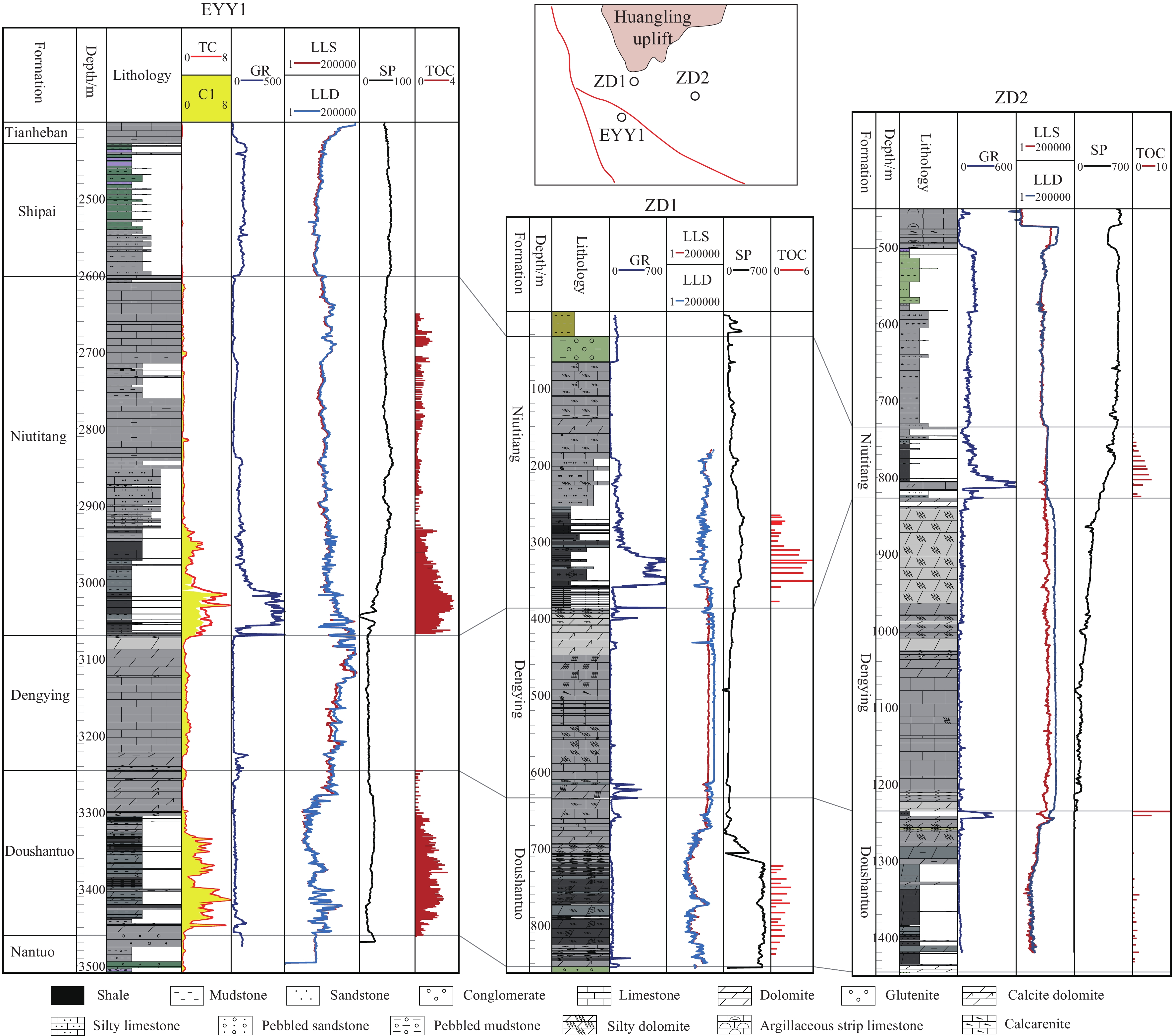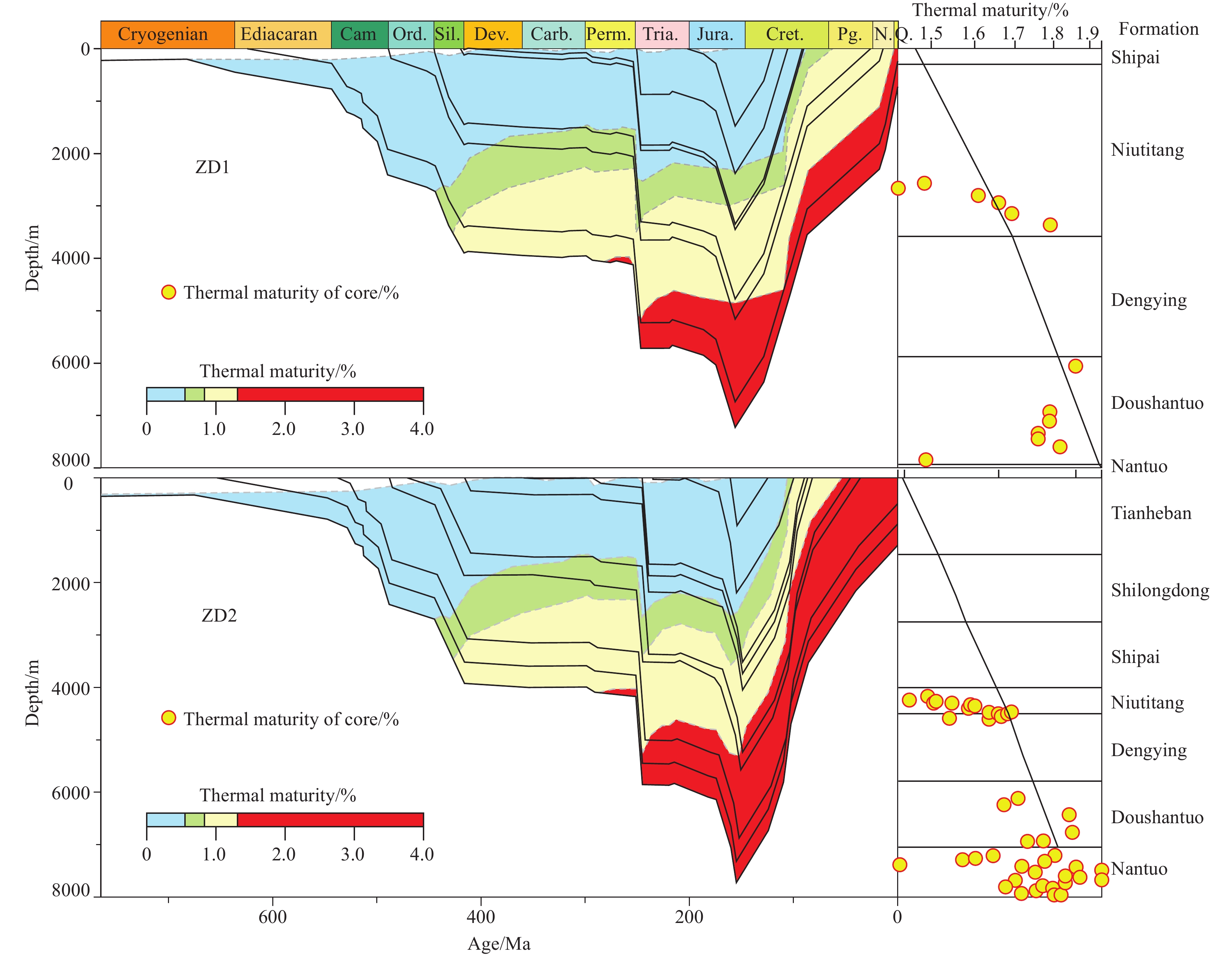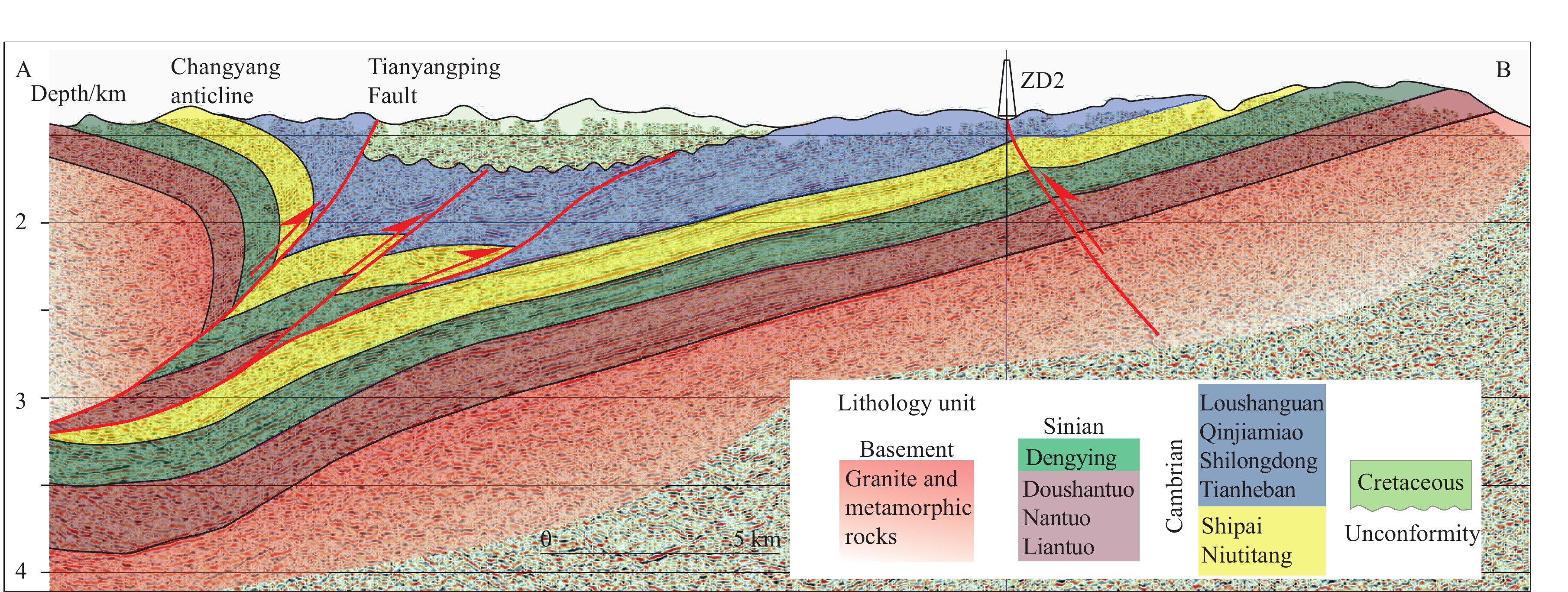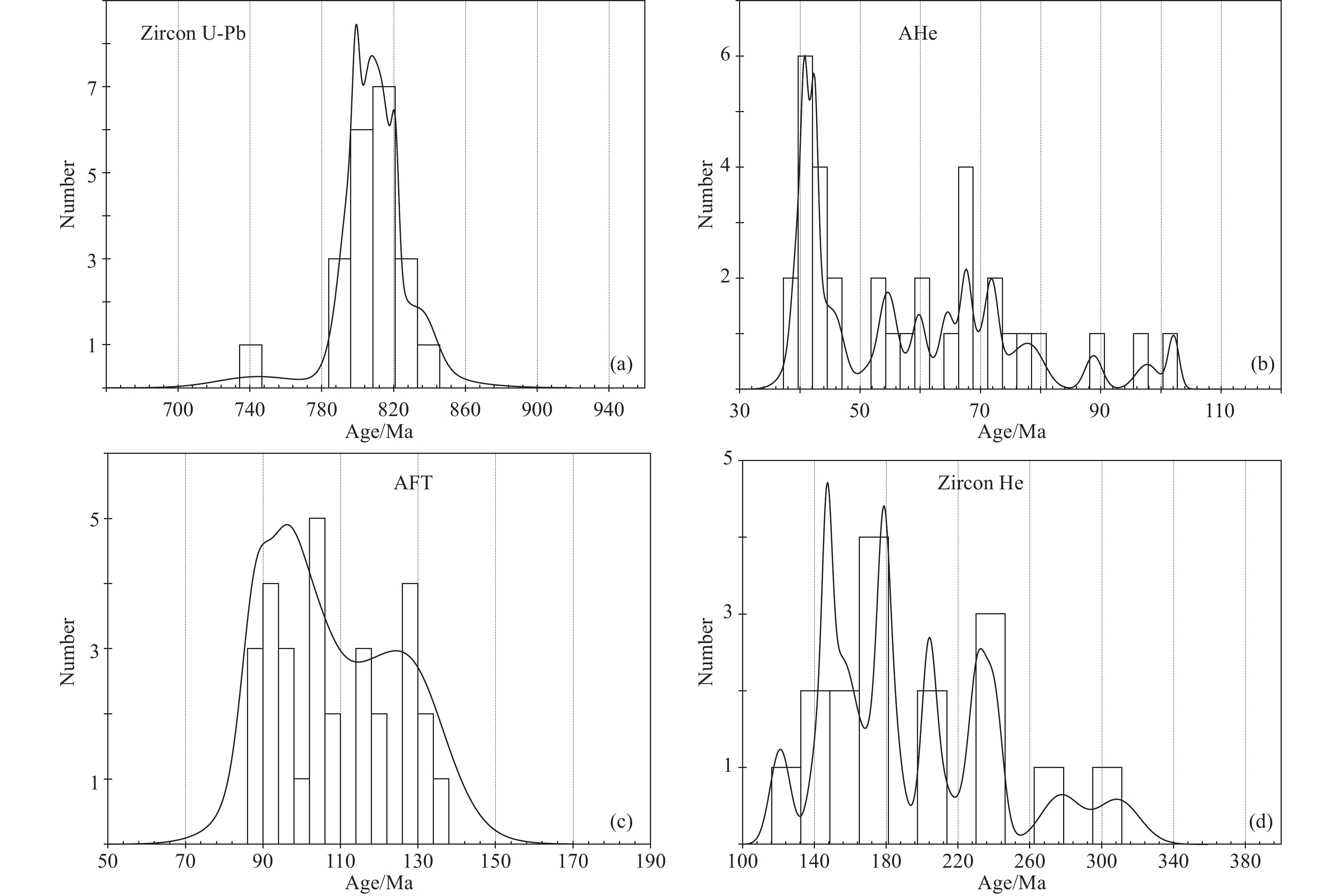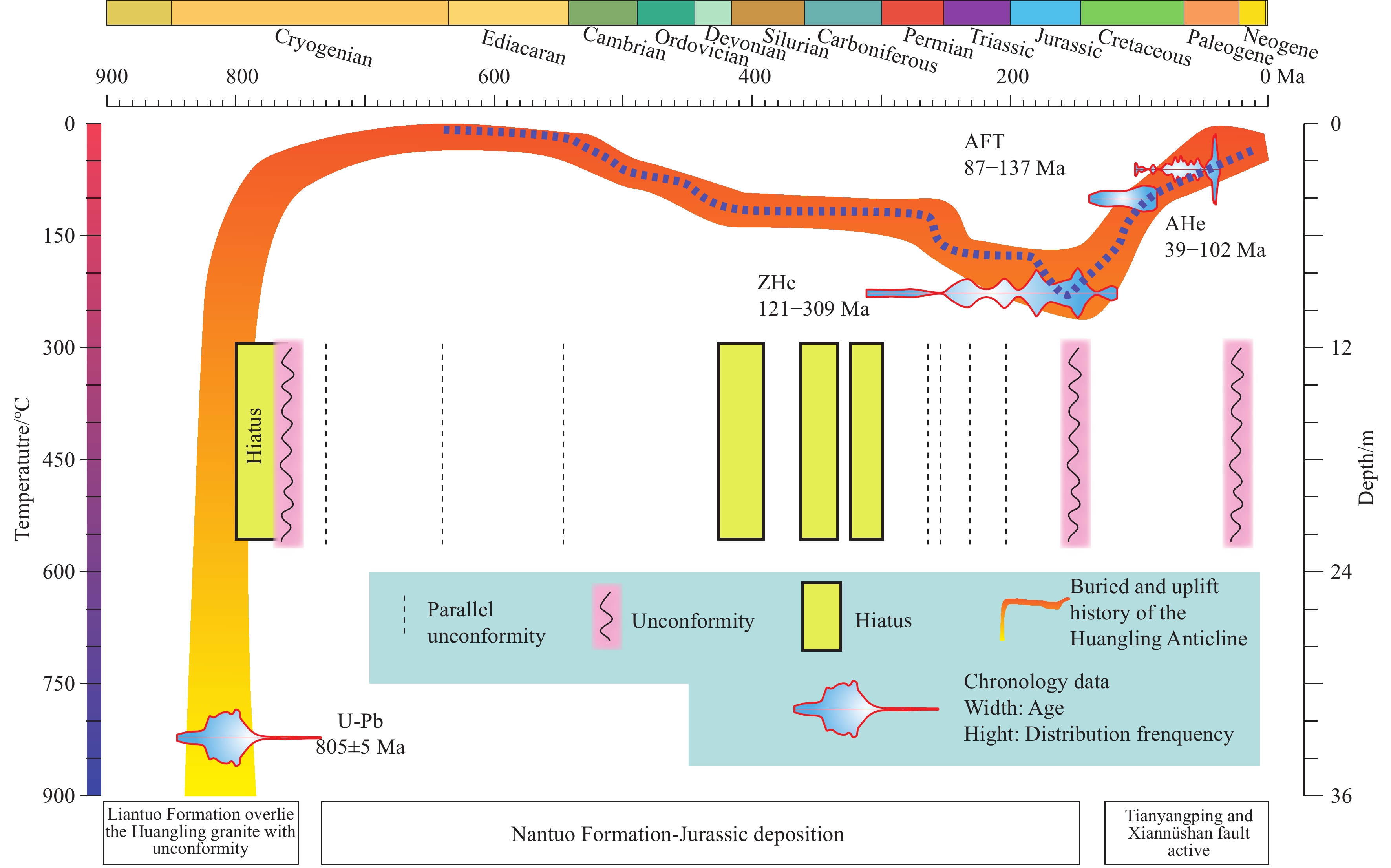| Citation: | Jun-feng Zhang, Gang-yi Zhai, Da-ming Wang, Shu-jing Bao, Ke Chen, Hao-han Li, Teng Song, Peng Wang, Zhi Zhou, 2020. Tectonic evolution of the Huangling dome and its control effect on shale gas preservation in the north margin of the Yangtze Block, South China, China Geology, 3, 28-37. doi: 10.31035/cg2020025 |
Tectonic evolution of the Huangling dome and its control effect on shale gas preservation in the north margin of the Yangtze Block, South China
-
Abstract
Significant breakthroughs of shale gas exploration have been made in Lower Cambrian and Sinian shale in the north margin of the Yangtze Block, South China. The drill wells with industrial gas flow located in the southern margin of the Huangling dome. Base on the geological survey, 2D seismic, geochronological and drill wells data, the tectonic evolution history of Huangling dome was studied, and its control effect on the preservation condition of shale gas was discussed. The result shows that the Huangling dome might undergo four tectonic stages: (1) About 800 Ma, granite intrusion in the Huangling dome basement, primarily of granites replaced metamorphism rocks; (2) 800–200 Ma, no significant tectonic movement with slowly buried history; (3) From 200 Ma, multi-phase uplift and the sedimentary rocks was eroded in the core of the Huangling dome. Shale gas in the Cambrian and Sinian strata was well preserved in the margin of the Huangling dome as the following reasons: (1) The Sinian shale was buried about 7.8 km in-depth during Middle Jurassic, source rocks have a suitable thermal maturity for shale gas; (2) The rigid basement of the Huangling dome was mainly composed by homogeneity granite, without intensive deformation. As the main challenges of the widely distributed Lower Cambrian and Sinian shale are high-maturity and intensive deformation, a geological unit with a dome probably is a favorable zone for the old age shale gas. Therefore, it indicates that the adjacent zone of the Xuefengshan, Shennongjia and Hannan are the geological units with a dome and probably have potentials for the exploration of shale in the Lower Cambrian and Sinian.
-

-
References
[1] Bao SJ, Zhai GY, Zhou Z, Yu SF, Chen K, Wang YF, Wang H, Liu YM. 2018. The evolution of the Huangling uplift and its control on the accumulation and preservation of shale gas. China Geology, 1, 353. doi: 10.31035/cg2018052 [2] Bücker HM, Kauerauf AI, Rasch A. 2008. A smooth transition from serial to parallel processing in the industrial petroleum system modeling package PetroMod. Computers & Geosciences, 34, 1473–1479. doi: 10.1016/j.cageo.2008.01.011 [3] Chen XH, Luo SY, Liu A, Li H. 2018. The oldest shale gas reservoirs in southern margin of Huangling uplift, Yichang, Hubei, China. China Geology, 1, 159. doi: 10.31035/cg2018013 [4] Dong DZ, Zou CN, Li JZ, Wang SJ, Li XJ, Wang YM, Chen GS, Wang SQ, Lü ZG, Huang YB. 2012. Progress and prospects of shale gas exploration and development in China. Acta Petrolel Sinica, 33(S1), 107–114 (in Chinese with English abstract). [5] Energy Information Administration (EIA). 2013. Technically Recoverable Shale Oil and Shale Gas Resources: An Assessment of 137 Shale Formations in 41 Countries outside the United States. Energy Information Administration Report, 20. [6] Feng DY, Lin ZC, Zhang ZC. 1991. Intrusive ages and isotopic characteristics of massives in the south of Huangling granitoids. Hubei Geology, 5(2), 1–12 (in Chinese). [7] Gao W, Zhang CH. 2009. Zircon SHRIMP U-Pb ages of the Huangling granite and the tuff beds from Liantuo Formation in the Three Gorges area of Yangtze River, China and its geological significance. Geological Bulletin of China, 28(1), 45–50 (in Chinese with English abstract). [8] Guo TL, Zhang HR. 2014. Formation and enrichment mode of Jiaoshiba shale gas field, Sichuan Basin. Petroleum Exploration and Development, 41(1), 28–36 (in Chinese with English abstract). [9] Guo XS, Hu DF, Wen ZD, Liu RB. 2014. Major factors controlling the accumulation and high productivity in marine shale gas in the Lower Paleozoic of Sichuan Basin and its periphery: A case study of the Wufeng-Longmaxi Formation of Jiaoshiba area. Geology in China, 41(3), 893–901 (in Chinese with English abstract). [10] Guo YF. 2010. The efficient hydrocarbon supply of the high-over mature source rock in the wester of the middle Yangtze region: Taking the cambrian as an example. PhD thesis, Xian, Xi’an Shiyou University (in Chinese with English abstract). [11] Hao F, Zou HY, Lu YC. 2013. Mechanisms of shale gas storage: Implications for shale gas exploration in China. AAPG Bull, 97(8), 1325–1346. doi: 10.1306/02141312091 [12] Hu JM, Chen H, Qu HJ, Wu GL, Yang JX, Zhang ZY. 2012. Mesozoic deformations of the Dabashan in the southern Qinling orogen, central China. Journal of Asian Earth Science, 47, 171–184. doi: 10.1016/j.jseaes.2011.12.015 [13] Hu SB, Raza A, Min K, Kohn BP, Reiners PW, Ketcham RA, Wang JY, Gleadow AJW. 2006. Late Mesozoic and Cenozoic thermotectonic evolution along a transect from the north China craton through the Qinling orogen into the Yangtze craton, central China. Tectonics, 25(6), TC6009. doi: 10.1029/2006TC001985 [14] Hu SL, Liu HY, Wang SS, Hu WH, Sang HQ, Qiu J. 1989. On the age of Sinian Lower Boundary infered from the new Ar/Ar data. Scientia Geologica Sinica, 1, 16–25. [15] Hubei Geological Investigation Agency. 2011. Sandouping Geological and Mineral Map, 1∶50000. [16] Hubei Province Bureau of Geology and Mineral Resources. 1996. Hubei Province Lithostratigraphy. Beijing, China University of Geosciences Press (in Chinese). [17] Ji WB, Lin W, Faure M, Chu Y, Wu L, Wang F, Wang J, Wang QC. 2014. Origin and tectonic significance of the Huangling massif within the Yangtze craton, South China. Journal of Asian Earth Science, 86, 59–75. doi: 10.1016/j.jseaes.2013.06.007 [18] Jiang LS, Chen TL, Zhou ZY. 2002. Several principal geological problems in Hualing. Hubei Geology & Mineral resources, 16(1), 8–13 (in Chinese with English abstract). [19] Li TY, He S, He ZL, Wu YJ, Zhou Y, Wang FR, Yang XY. 2012. Reconstruction of tectonic uplift and thermal history since Mesozoic in the Dangyang synclinorium of the central Yangtze area. Acta Petrolei Sinica, 33(2), 213–224 (in Chinese with English abstract). [20] Li XM, Shan YH. 2011. Diverse exhumation of the Mesozoic tectonic belt within the Yangtze Plate, China, determined by apatite fission-track thermochronology. Geosciences Journal, 15(4), 349–357. doi: 10.1007/s12303-011-0037-5 [21] Li YL, Zhou HW, Li XH, Luo QH. 2007. 40Ar-39Ar plateau ages of biotite and amphibole from tonalite of Huangling granitoids and their cooling curve. Acta Petrologica Sinica, 23(5), 1067–1074 (in Chinese with English abstract). [22] Li YX, Nie HK, Long PY. 2009. Development characteristics of organic rich shale and strategic selection of shale gas exploration area in China. Natural Gas Industry, 29(12), 115–118 (in Chinese with English abstract). [23] Li ZC, Wang GH, Zhang ZC. 2002. Isotopic age spectrum of the Huangling granitic batholith, western Hubei. Geology and Meneral Resources of South China, 3, 19–28 (in Chinese with English abstract). [24] Li ZX, Evans DAD, Zhang SH. 2004. A 90° spin on Rodinia: Possible causal links between the Neoproterozoic super-continent, super plume, true polar wander and low-latitude glaciations. Earth and Planet Science Letters, 220(3−4), 409–421. doi: 10.1016/S0012-821X(04)00064-0 [25] Li ZX, Li XH. 2007. Formation of the 1300 km wide intracontinental orogen and postorogenic magmatic province in Mesozoic South China: A flat-slab subduction model. Geology, 35(2), 179–182. doi: 10.1130/G23193A.1 [26] Liang DG, Guo TL, Chen JP, Bian LZ, Zhao Z. 2008. Some new advances in the study of hydrocarbon generation and accumulation in marine sedimentary regions in South China (I): Distribution of four sets of regional marine source rocks in South China. Marine Origin Petroleum Geology, 13, 1–16 (in Chinese with English abstract). [27] Ling WL, Gao S, Cheng JP, Jian LS, Yuan HL, Hu ZC. 2006. Neoproterozoic magmatic events within the Yangtze continental interior and along its northern margin and their tectonic implication: Constraint from the ELA-ICPMS U-Pb geochronology of zircons from the Huangling and Hannan complexes. Acta Petrologica Sinica, 22(2), 387–396 (in Chinese with English abstract). [28] Liu HJ, Xu CH, Zhou ZY, Donelick RA. 2009. The AFT geochronology data constrain of the Huangling uplift (165−100Ma). Progress in Natural Science, 19(12), 1326–1332. [29] Liu J. 2008. Geothermal field evolution and organic maturity of Mesozoic and Paleozoic in Western Hubei-Eastern Chongqing Area. PhD thesis, China University of Wuhan (in Chinese with English abstract). [30] Lu QZ, Hu SB, Guo TL, Li ZP. 2005. The background of the geothermal field for formation of abnormal high pressure in the northeastern Sichuan basin. Chinese Journal of Geophysics, 48(5), 1110–1116. [31] Lu QZ, Ma YS, Guo TL, Hu SB. 2007. Thermal history and hydrocarbon generation history in western Hubei-Eastern Chongqing area. Chinese Journal of Geology, 42(1), 189–198 (in Chinese with English abstract). [32] Ma DQ, Du SH, Xiao ZF. 2002. The origin of Huangling granite batholith. Acta Petrologica et Mineralogica, 21(2), 151–161. [33] Ma DQ, Li ZC, Xiao ZF. 1997. The constitue, Geochronology and Geologic evolution of the Kongling complex, Western Hubei. Acta Geoscientia Sinica, 18(3), 233–241. [34] Ma GG, Li HQ, Zhang ZC. 1984. The research of the Sinian time limit range. Yichang Institute of Geology and Mineral Resources, Chinese Academy of Geological Sciences, the No.8 (in Chinese). [35] Piñero E, Hensen C, Haeckel M, Rottke W, Fuchs T, Wallmann K. 2016. 3-D numerical modelling of methane hydrate accumulations using PetroMod. Marine and Petroleum Geology, 71, 288–295. doi: 10.1016/j.marpetgeo.2015.12.019 [36] Richardson NJ, Densmore AL, Seward D, Wipf M, Yong L. 2010. Did Incision of the Three Gorges Begin in the Eocene? Geology, 38, 551–54. doi: 10.1130/G30527.1 [37] Shen CB, Mei LF, Liu ZQ, Xu SH. 2009. Apatite and zircon fission track data, evidences for the Meosozic-Cenozoic uplift of Huangling Dome. Central China. Journal of Mineralogy and Petrology, 29(2), 54–60 (in Chinese with English abstract). [38] Wang YF, Zhai GY, Lu YC, Ma YQ, Li J, Liu GH, Zhang YX. 2019. Sedimentary lithofacies characteristics and sweet-spot interval characterization of the Sinian Doushantuo Formation in Upper Yangtze Platform, South China. China Geology, 2, 261–275. doi: 10.31035/cg2018119 [39] Xiao CH. 2010. Study on marine oil and gas seal up for safekeeping system in the Middle Yangtze region. Chengdu, Chengdu University of Technology (in Chinese with English abstract). [40] Xu CH, Zhou ZY, Chang Y, Guillot F. 2010. Genesis of Daba arcuate structural belt related to adjacent basement up-heavals: Constraints from Fission-track and (U-Th)/He thermochronology. Science China-Earth Sciences, 53(11), 1634–1646. doi: 10.1007/s11430-010-4112-y [41] Xu ES, Li ZM, Yang ZH. 2015. Thermal and hydrocarbon generation history of Wufeng and Longmaxi shales in Pengshui area, eastern Sichuan Basin: A well PY1 case study. Petroleum Geology& Experiment, 37(4), 494–499 (in Chinese with English abstract). [42] Zhang DW. 2011. Main solution ways to speed up shale gas exploration and development in China. Natural Gas Industry, 31(5), 1–5. [43] Zhang F, Lin WZ, Zhou JY. 1998. AFT study of the time along the Xiannüshan fault in the Three Gorges area. Chinese Science Bulletin, 43(23), 2554–2556. doi: 10.1360/csb1998-43-23-2554 [44] Zhang HD. 1986. The preliminary study of the formation and structural evolution of the Huangling anticline. Journal of the Jianghan petroleum institute, 1, 29–40. [45] Zhang JC, Jiang SL, Tang X, Zhang PX, Tang Y, Jin TY. 2009. Accumulation types and resources characteristics of shale gas in China. Natural Gas Industry, 29(12), 109–114 (in Chinese with English abstract). [46] Zhang SB, Zheng YF, Zhao ZF, Wu YB, Yuan HL, Wu FY. 2008. Neoproterozoic anatexis of Archean Lithosphere: Geochemical evidence from felsic to mafic intrusive at Xiaofeng in the Yangtze George, South China. Precambrian Research, 163, 210–238. doi: 10.1016/j.precamres.2007.12.003 [47] Zhang SB, Zheng YF, Zhao ZF, Wu YB, Yuan HL, Wu FY. 2009. Origin of TTG like rocks from anatexis of ancient lower crust: Geochemical evidence from Neoproterozoic granitoids in South China. Lithos, 113, 347–368. doi: 10.1016/j.lithos.2009.04.024 [48] Zhang Y, Chen C, Liang Q, Wang LS, Du JS, Liu SB. 2012. Density structure of upper and middle crust in three gorges reservoir area. Earth Science (Journal of China University of Geosciences), 37(S1), 217–226 (in Chinese with English abstract). [49] Zou CN, Dong DZ, Wang YM, Li XJ, Huang JL, Wang SF, Guan QZ, Zhang CC, Wang HY, Liu HL, Bai WH, Liang F, Lin W, Zhao Q, Liu DX, Yang Z, Liang PP, Sun SS, Qiu Z. 2016. Shale gas in China: Characteristics, challenges and prospects (II). Petroleum exploration and Development, 43(2), 166–78 (in Chinese with English abstract). -
Access History

-
Figure 1.
The geological map of Huangling dome. a–tectonic position of the Huangling dome (modified from Ji W et al., 2014); b–geological map of Huangling dome southern wing (after Hubei Geological Investigation Agency, 2011); c–geological section of Huangling dome southern limb (based on 2D seismic sections).
-
Figure 2.
East-West comparison of drilled wells EYY1, ZD1 and ZD2 (refer to Fig. 1b for the position).
-
Figure 3.
Sedimentary burial history analysis of Well ZD1 and Well ZD2.
-
Figure 4.
Geological section of southern margin of Huangling dome across Tianyangping fault according to 2D seismic data (refer to Fig. 1b for the position).
-
Figure 5.
Chronological data statistical graph of Huangling dome and its surrounding area. a–zircon U-Pb dating data; b–the helium of the apatite dating data; c–apatite fission-track dating data; d–the helium of zircon dating data.
-
Figure 6.
The tectonic evolution history of Huangling dome basement (Refer to Fig. 3 for sedimentary burial history data; refer to Fig. 5 for geochronological data). U-Pb–zircon uranium-lead age; ZHe–zircon helium age; AFT–apatite fission-track age; AHe–apatite helium age.
-
Figure 7.
Schematic illustration showing Huangling dome uplifting. (a–continuous deposition in Huangling dome and its adjacent area during Triassic; b–Huangling dome started to lift during Late Jurassic; c–Tianyangping Fault and Xiannüshan Fault began to take shape during Late Cretaceous; d–the current tectonic geometry takes shape.





 DownLoad:
DownLoad:
